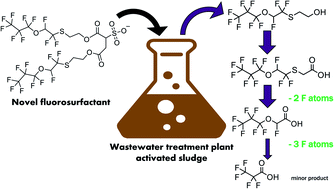Aerobic biotransformation of a novel highly functionalized polyfluoroether-based surfactant using activated sludge from a wastewater treatment plant†
Abstract
A replacement fluorosurfactant has been recently introduced to the European market as an alternative to other per- and polyfluoroalkyl substances (PFAS) that have been phased-out or banned. Here, we incubated this novel fluorosurfactant (diFESOS, [F7C3OCHFCF2SCH2CH2OC(O)]2C2H3SO3−) which contains ether and thioether insertions, and its known polyfluoroalkyl degradation products, an alcohol (FESOH) and carboxylic acid (FESCA), with activated sludge from a wastewater treatment plant under sulfur-limited conditions. Dosed chemicals and their transformation products were monitored using ultra-high performance liquid chromatography-tandem mass spectrometry, and gas chromatography-mass spectrometry. In addition to FESOH and FESCA, two smaller metabolites were identified: C3F7OCHFCOO− (2H-3:2 PFECA) and perfluoropropanoic acid (PFPrA). 2H-3:2 PFECA presumably was a result of S-dealkylation of FESCA, which then resulted in the abiotic cleavage of two C–F bonds; no S-oxygenation was observed. Overall, the terminal products of this biotransformation likely have lower bioaccumulation potential than the parent fluorosurfactant based on comparison to other similar PFAS.

- This article is part of the themed collection: Environmental Science: Processes & Impacts Recent HOT Articles


 Please wait while we load your content...
Please wait while we load your content...